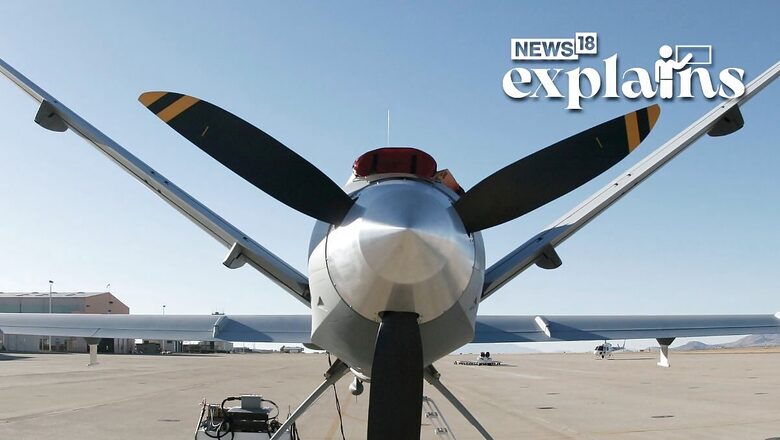
views
Even as Prime Minister Narendra Modi prepares for his visit to the United States, the Defence Ministry granted approval on Thursday for the acquisition of Predator (MQ-9 Reaper) drones from America. The final decision on the deal will be made by the Cabinet Committee on Security (CCS), ANI reported.
“The deal for the Predator drones was given approval by the Defence Acquisition Council meeting today. The acquisition proposal will now have to follow a procedure after which it will have to be cleared by the Cabinet Committee on Security,” ANI quoted defence sources as saying.
About the Deal
The DAC, as the highest authority in the Defence Ministry for acquisition decisions, plays a crucial role in approving acquisitions. However, final approval for high-value acquisitions is granted by the Cabinet Committee on Security (CCS).
In this specific deal, the Indian Navy is leading the acquisition process, with the intention of acquiring 15 drones for conducting surveillance operations within its designated area of responsibility, the report said.
Additionally, the Indian armed forces have plans to procure similar medium altitude and long endurance drones from domestic sources, as part of their efforts to enhance indigenous capabilities.
Why Does India Need the Drones?
According to an India Today report, military planners view the acquisition of Predator armed drones as a means to enhance India’s offensive capabilities. As the deal progresses, General Atomics Aeronautical Systems, the manufacturer of these drones, has partnered with Bharat Forge to produce landing gear components, subassemblies, and assemblies for remotely piloted aircraft, specifically the Predator drones.
The collaboration between the two companies is expected to contribute to the development of capabilities for both sides and bolster the unmanned aircraft industry in India. This partnership is seen as a significant step in advancing the technological capabilities and expertise in the field of unmanned aerial systems, the report states.
About the Drones
The MQ-9B SeaGuardian is a maritime-focused drone that offers advanced capabilities for extended endurance and versatile operations. With a flight endurance of over 30 hours and the ability to operate in all weather conditions, the SeaGuardian can conduct long-range surveillance and deliver real-time situational awareness in the maritime domain, according to a report by Business Today.
The drone’s integration into civil airspace allows for joint operations and collaboration between military forces and civil authorities, enabling effective responses in various scenarios such as humanitarian assistance, disaster relief, search and rescue, law enforcement, anti-surface warfare, anti-submarine warfare, airborne mine countermeasures, long-range strategic intelligence, over-the-horizon targeting, and anti-submarine warfare, the report adds.
The Quad countries, including the United States, India, Australia, and Japan, have operated or currently operate the MQ-9B SeaGuardian. In the interview with PTI, Vivek Lall, the chief executive of General Atomics Global Corporation, emphasized the capabilities of the MQ-9B drone and its potential benefits for the Indian military. He stated that the MQ-9B would surpass any other aircraft in its category in terms of operational range, endurance, and mission versatility.
According to Lall, the MQ-9B, including its variants SkyGuardian and SeaGuardian, is equipped with advanced systems that allow it to capture full-motion video in various conditions, whether it’s day or night. Additionally, the drone’s onboard systems enable it to perform detailed sensing, enhancing its ability to gather intelligence and carry out a wide range of missions.
Key Features
The MQ-9 Reaper drones offer a wide range of capabilities that make them highly versatile for various military operations, according to a Hindustan Times report. They are equipped to perform strike, coordination, and reconnaissance missions, particularly against time-sensitive and high-value targets. This capability makes them well-suited for irregular warfare operations that support the objectives of combatant commanders.
The drones are capable of conducting intelligence, surveillance, and reconnaissance (ISR) missions, providing valuable real-time information and situational awareness. They can also provide close air support, assist in combat search and rescue operations, engage in precision strikes, conduct convoy and raid overwatch, assist in route clearance, aid in target development, and provide terminal air guidance, the report says.
The baseline system of the MQ-9 carries the Multi-Spectral Targeting System (MTS-B), which integrates various sensors such as infrared, color and monochrome daylight TV cameras, shortwave infrared camera, laser designator, and visual sensors for precise targeting. It also includes a laser rangefinder/designator for accurately designating targets for laser-guided munitions, as well as a synthetic aperture radar for enhanced surveillance capabilities.
Furthermore, the MQ-9 can carry up to eight laser-guided missiles, specifically the Air-to-Ground Missile-114 Hellfire. These missiles possess high accuracy, low collateral damage, and are effective against both armored and personnel targets.
In terms of logistics, the MQ-9 can be disassembled and loaded into a single container for deployment, and it can be transported using aircraft such as the C-130 Hercules or larger platforms. This enhances its mobility and flexibility for deployment in various operational theaters, the report adds.

















Comments
0 comment